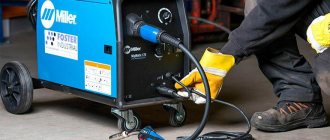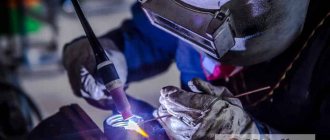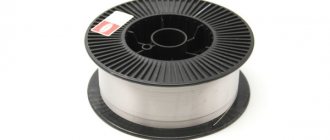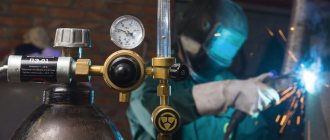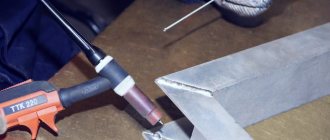The most productive gases for semi-automatic welding: how do professionals approach this issue?
Today there are many modes and types of welding.
Some types require portable (inverter) power supplies, while others can only be used in a workshop environment under the supervision of several specialists. To get a good, even and durable seam, you need to follow all the rules, know what gases will be optimal for this device and what rules you need to follow when working with metals. Indicators of how much gas is consumed can be as follows:
| Wire diameter (cm) | Current (Ampere) | Average flow rates (liters per minute) |
| 0,8 — 1 | 60 — 160 | 8 |
| 1,2 | 100 — 250 | 9 — 12 |
| 1,4 | 120 — 320 | 12 — 15 |
| 1,6 | 240 — 130 | 15 — 18 |
| 2 cm | 280 — 450 | 18 — 20 |
Brief description of gases used to create mixtures
Argon is a colorless, odorless, tasteless gas, non-flammable and non-toxic. However, any mixture of Ar with other gases can displace oxygen from the room, which can lead to suffocation of workers if the proportion of oxygen drops below 19% of the total volume. Argon is heavier than the air mixture and can accumulate in poorly ventilated areas near the floor.
Nitrogen is a colorless and non-flammable gas. Odorless and tasteless, non-toxic. However, the accumulation of a nitrogen gas mixture can cause oxygen deficiency and even suffocation when the oxygen concentration decreases to less than 19% of the volume.
Carbon dioxide is a colorless gas, non-flammable and non-toxic, with a specific sour taste. The maximum permissible concentration of the compound in the air of the working area is 9 g/m3 (which is equal to 0.5% of the volume). If the concentration becomes more than 5%, carbon dioxide can have a harmful effect on the physical condition of workers. Carbon dioxide is one and a half times heavier than the air mixture and can accumulate in unventilated rooms near the floor, in pits. When the oxygen concentration in the air drops below 19%, oxygen starvation and suffocation occur.
Helium is a colorless gas, tasteless and odorless, non-toxic and non-flammable, lighter than an air mixture, therefore it accumulates at the top of workshops.
Oxygen is a colorless, odorless, tasteless, non-flammable gas, although it itself is not toxic or explosive, however, being a strong oxidizing agent, it significantly increases the susceptibility of other materials to combustion. If oxygen accumulates in the air of workshops, it can cause fires and subsequently fires. It is important that the volume fraction of gas in working (production) areas should not be more than 23%.
Argon, carbon dioxide and oxygen
Carbon dioxide (5-20%) and argon (80-95%) are used to create permanent joints from steels: structural alloy and carbon. Pros: transfer is carried out by jet or drip. The arc burns stably. If you use a mixture with the addition of oxygen (2%), reducing the carbon dioxide content to 6%, then it will be easier for the welder to cope with thin alloys.
Argon and helium
The combination of helium (70%) and argon (30%) will allow you to work with any thick alloys:
- steel;
- cast iron;
- non-ferrous metals.
At the same time, the welding speed will increase due to the elimination of the operation of preheating the parts. The number of defects - porosity of seams, cracks - will be reduced to a minimum.
The disadvantage should be considered the high cost of such mixtures due to the high content of rare helium. Therefore, similar proportions are used when welding especially critical structures - when creating products for space or the military-industrial complex.
Argon plus helium (50% each) - the mixture is considered universally inert. Thanks to this, you can work with most alloys - both non-ferrous and ferrous. A composition of 70% argon and 30% helium, compared to pure argon, cools the welding zone better and is used for joining parts of medium thickness, if it is necessary to obtain seams with a minimum of defects. A mixture of 60% argon, 38% helium and 2% carbon dioxide is used for welding alloy and structural carbon alloys. At the same time, the arc is stable and the amount of splashes is reduced.
Argon and hydrogen
Used in production when working with austenitic (heat-resistant) alloys. The mixture allows you to improve the characteristics of the resulting seam and achieve greater elasticity . Often used when working during the creation of space and aircraft technology. The percentage of chemical elements content depends on the grade of steel.
Welding mixture for semi-automatic machine
When choosing a mixture for a semi-automatic machine, a specialist takes into account the following criteria: type of workpiece material, diameter of the wire used, optimal thickness of the weld. In practice, to select a mixture, it is enough to compare the data given in special tables. Here, the optimal composition options for working with specific materials have already been selected, taking into account the technological features of the process.
An experienced welder also takes into account the associated effects of using one or another gas mixture. For example, the use of carbon dioxide makes it possible to reduce splashing. Therefore, they are often chosen for forming ceiling joints.
Composition and areas of application
There are many types of gas compositions for MIG-MAG welding. The most widely used mixtures are argon and carbon dioxide. They are widely used both for working with low-carbon steels and for high-alloy (stainless, heat-resistant, etc.) steel grades.
Less common are mixtures with the addition of oxygen, which work better in the presence of rust or surface contamination, but are characterized by greater metal loss and smoke emissions. In addition, they are not applicable to high-alloy steels.
Gas consumption for welding. Shielding gas calculation
In this article we will look at the consumption of electrodes and gases, recommended consumption rates and how to calculate the consumption yourself. Let's consider some features of calculating the consumption of materials during welding work, for what reasons the consumption may increase. In our article we will also give a couple of formulas on how you can independently calculate the recommended consumption of welding materials.
Calculating the consumption of electrodes for welding is one of the important stages of preparatory work. By using one of the existing methods for calculating electrode consumption, you don’t have to worry about having to interrupt the welding process due to a lack of filler material, which will undoubtedly affect the quality of the work performed.
Nowadays, welding occupies a dominant position in the joining of metal products. Welding forms the basis in mechanical engineering, construction, etc. Thus, knowledge about welding processes and the use of materials such as fluxes becomes important. In this article you will become familiar with the principle of operation of fluxes and the features of their use during aluminum welding.
stalevarim.ru
What gas is suitable for welding work?
For amateur welding at home, it is better to choose semi-automatic machines that can be connected to a standard 220 V network, but this is not the only condition for the correct selection of equipment. Users are often confused by the markings on tools: MAG, MIG. What does this abbreviation mean?
- MAG is a semi-automatic machine for working with carbon.
- MIG is a semi-automatic device for working with argon.
It is also possible to combine these gases or use mixtures in which they are the basis. The final result and the quality of the welded joint depend on the composition of the mixtures used. MAG or MIG requires the use of a specific type of filler wire. Universal versions of semi-automatic machines are capable of operating with any gas mixture.
Experienced welders advise using a mixture of carbon dioxide/argon, 20/80, respectively, for semi-automatic welding. The composition of the gas in this proportion greatly facilitates welding work, allows you to obtain an absolutely even, high-quality welded joint, and the resulting seam does not require additional processing.
Gas saving
We said above that gas consumption is also influenced by indirect factors that the welder has virtually no influence on. But he can still, if possible, minimize the effect of these factors, thereby saving gas.
The simplest thing you can do is to weld in a closed workshop with good ventilation. There should be no drafts or wind. It is also better to involve qualified, experienced welders who perform the work quickly and accurately. After all, for beginners, in any case, gas consumption will be much higher.
Many novice welders are interested in whether there is any other way to reduce co2 consumption during semi-automatic welding? For example, simply supply less gas to the welding zone. Our answer: no. By deliberately reducing the amount of gas used, you will deteriorate the quality of the seam, since oxygen will enter the welding zone.
But this problem still has a solution. Experienced craftsmen advise using multi-component gas mixtures in their work; thanks to them, consumption is reduced, while the quality of welding remains at a decent level. But be prepared for the fact that the cost of multicomponent mixtures is much higher than that of standard gas. So make sure that using such mixtures is cost-effective.
Consumption factors
The most significant conditions for the consumption of the welding mixture - a controlled atmosphere - are the following mediators:
- Type and thickness of metal being connected.
- Welding rod diameter.
- Current strength of the welding machine.
Taking into account each of the above factors, the consumption of the protective medium can be derived. The data below determines the amount of welding mixture output when operating semi-automatically, taking into account the wire diameter and current strength:
- wire 0.8-1.0 mm, device current 60-160 amp. — 8 liters of gas per minute;
- 1.2 mm, 100-200 A - 9.5-12 l/min;
- 1.4 millimeters, 120-320 apm. — 12-15 l;
- 1.6 mm, 240-380 - from 15 to 18 liters;
- 2.0 mm, 280-450 A - up to 20 l/min.
Examples of welds with different voltage settings
The voltage determines the height and width of the weld.
The photo shows welds on 1.2 mm thick sheet metal made with increasing stress (from left to right). Seams made on low settings turned out narrow and tall, while on high settings they turned out wide and flat.
The photo on the left shows seams on sheet metal made under increasing stress.
From left to right from lower voltage to higher voltage. In the second photo, the reverse side of the sheet shows penetration (penetration). If you look from the reverse side, the two seams on the left did not have good penetration (welding) along the entire length. The three seams on the right have good penetration along the entire length.
Welding seams in section These
On the first two there is a seam at the top, but it did not penetrate the metal at all. The third one has both a top seam and good penetration and is the best seam of all. The two seams on the right have more penetration under the sheet than on top because the tension settings are too high.
How long do carbon dioxide cylinders of different sizes last?
As you know, a standard 40-liter cylinder contains 24 kg of CO2, which, when evaporated, forms about 12,000 dm³ of the gas phase. Taking into account the above data, it is possible to determine how long a carbon dioxide cylinder lasts during a continuous working process.
Here is an ordinary 40 liter cylinder filled with carbon dioxide
So, for example, when using a 1 mm wire and an average current of 100 A, 40 liters of gas will last approximately 24 hours. Accordingly, a 10 liter cylinder should be enough for 6 hours of continuous use.
According to reference materials, 1.1 kg of CO2 and 1.35 kg of welding wire are consumed per 1 kg of deposited metal. Thanks to these data, the following proportion is determined: CO2/wire = 1:1.2 kg. That is, for 1.2 kg of wire material there is 1 kg of carbon dioxide in the liquid phase.
Based on the obtained coefficient, you can easily calculate consumption: 24 kg of carbon dioxide (40 liter capacity) is enough for 29 kg of welding metal. As practice shows, these calculations correspond to reality in most cases.


